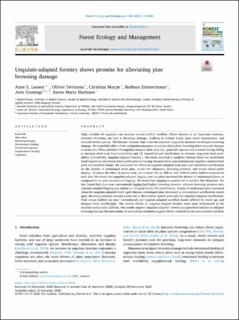| dc.description.abstract | High densities of ungulates can increase human-wildlife conflicts. Where forestry is an important economy, intensive browsing can lead to browsing damage, resulting in volume losses, poor stand regeneration, and reduced timber quality. The forestry industry thus looks for practical, long-term measures to mitigate browsing damage. We tested the effect of two mitigation measures on moose (Alces alces) browsing behaviour and damage to Scots pine (Pinus sylvetris): (1) ungulate-adapted slash piles (i.e., palatable species only) created during felling to increase short-term food availability and (2) intensified soil scarification to increase long-term food availability (collectively, ‘ungulate-adapted forestry’). Our study occurred in southern Norway where we established fixed vegetation and moose faecal pellet plots at varying distances from conventional and ungulate-adapted slash piles and scarified stands. We evaluated the effects of ungulate-adapted slash piles and intensified scarification on the density of undamaged Scots pine, moose bite diameters, browsing pressure, and moose faecal pellet density. To assess the effect of spatial scale, we created 250 m, 500 m, and 1000-m radius buffers centered on each plot. We found that ungulate-adapted logging near our plots increased the density of undamaged pines, as compared to no and conventional logging. We found that logging in general led to smaller bite diameters. We also found that plots near conventional logging had higher browsing pressure, whereas browsing pressure near ungulate-adapted logging was similar to unlogged stands. For scarification, density of undamaged pine increased when the ungulate-adapted stand aged whereas undamaged pine decreased as conventional scarification stands aged. Browsing pressure showed a response at the smallest spatial scale only for ungulate-adapted scarification. Peak moose habitat use near conventional and ungulate-adapted scarified stands differed by stand age and distance from scarification. The overall effects of ungulate-adapted forestry were most pronounced at the smallest spatial scale (250 m). Our results support ‘ungulate-adapted’ forestry as a practical solution to mitigate browsing damage but uncertainty in some of our estimates suggest further research on the area treated is needed. | en_US |

